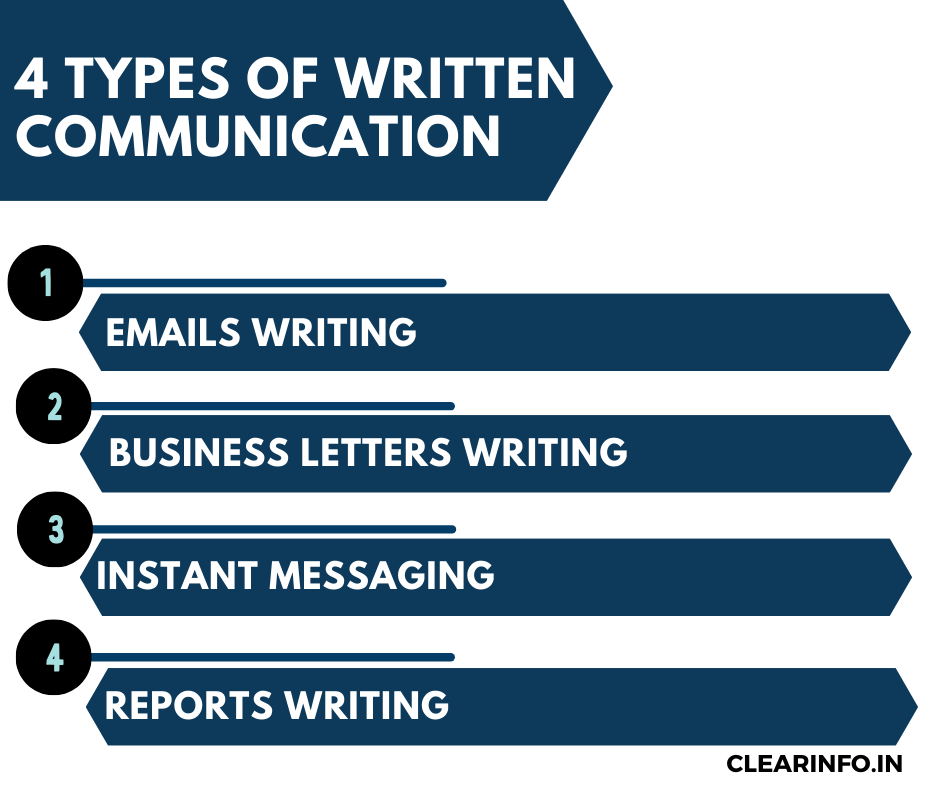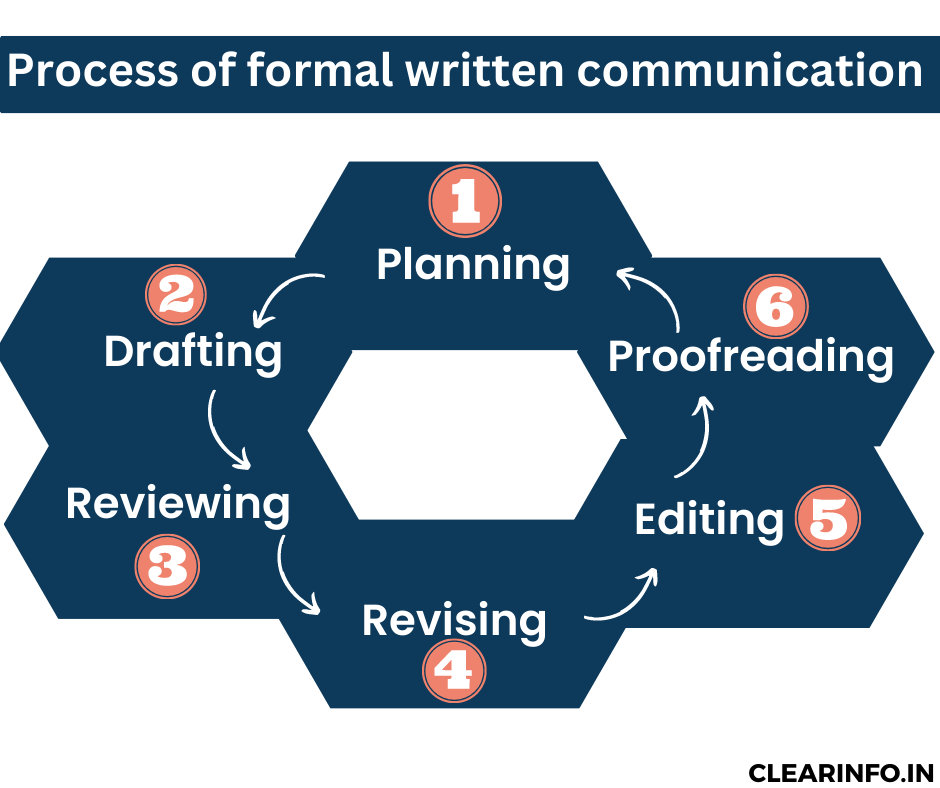Written word plays an increasingly important role whether sending emails, texting, or writing reports, we are constantly using written communication to convey our thoughts to others. But what exactly is written communication?
In this blog post, we’ll explore everything about written communication starting from the definition, types, importance, principles, and much more. So whether you’re a student, a professional, or simply looking to improve your communication skills, th is post is for you.
Definition of written communication
“Written communication is the art of conveying information or ideas through the written word. It is a form of expression that can be used to inform, persuade, entertain, or inspire.” – William Zinsser, On Writing Well,
What is written communication?
Written communication refers to the process of exchanging information or messages through written words. It can take many forms, including emails, letters, articles, social media posts, and even text messages. In written communication, the sender conveys a message to the receiver using written language, which can be understood and interpreted by the recipient.
This mode of communication is usually used when the sender and receiver are physically distant, or when a record of the communication is needed for future reference. Effective written communication involves using clear and concise language, organizing information logically, and considering the needs of the audience.
Nature of written communication
The nature of written communication is characterized by the use of written words to convey information, ideas, and messages. Written communication is typically more formal and structured than verbal communication.
The accessibility of written communication also allows for a wider audience to receive the message, regardless of time or distance. However, written communication can lack immediate feedback and emotional cues.
Scope of written communication
The scope of written communication is extensive, including various forms and purposes across many different fields. In the business context, written communication plays a crucial role in internal and external communication, including emails, proposals, and presentations.
In personal and social contexts, written communication is used for expressing emotions, sharing ideas, and building relationships through letters, and social media posts. Overall the scope of written communication is constantly evolving with the development of new technologies and mediums, making it an essential skill for effective communication.
What are the objectives of written communication?
Written communication is a critical tool for effectively conveying messages and achieving desired outcomes. Whether it’s for conveying information, persuading readers, or building relationships, the objectives of written communication are diverse. In this section, we will explore some common objectives of written communication that can help you communicate more effectively.
1/ Conveying information: The primary objective of written communication is to convey information or ideas clearly and effectively. This includes sharing facts, instructions, data, reports, or any other relevant details that need to be communicated effectively.
2/ Record-Keeping: A crucial objective of written communication is to maintain a permanent record of information or transactions. This can be important for legal or professional purposes, or simply to ensure that important details are not forgotten.
3/ Persuasion: Written communication can be a powerful tool for persuasion, whether in a marketing context or in advocacy work. This objective is common in advertising, marketing, and sales, where the goal is to convince the recipient to take a specific action
4/ Building relationships: Written communication can also be used to build and maintain relationships, whether in a personal or professional context. This can involve expressing gratitude, offering encouragement, or sharing personal insights.
5/ Informing and Educating: Written communication can be used to educate or inform readers about specific topics, whether through informative articles, textbooks, or instructional materials.
6/ Establishing Clarity: Written communication aims to eliminate ambiguity and ensure clarity in conveying messages. This objective involves using precise and well-structured language to avoid misunderstandings or misinterpretations.
Usage of written communication
The primary usage of written communication in business and professional settings are as follows:
- Advertising and Marketing: Written communication is essential in advertising and marketing, where it is used to promote products, services
- Legal Documentation: Written communication plays a critical role in legal contexts, where it is used for drafting legal documents, such as contracts and agreements.
- Business Communication: Written communication is extensively utilized for various business purposes. This includes writing emails, business reports, proposals, sales letters, and presentations.
- Social Media and Online Communication: With the rise of social media and digital platforms, written communication has become essential for online interactions.
What are the features of written communication?
Written communication has several unique features that make it an effective and adaptable method of conveying messages. Understanding the objectives of written communication can help you craft messages that are well-received and achieve your desired outcomes. In the following section, we will explore some common objectives of written communication
1/ Permanence: Written communication is typically a permanent record of the message being conveyed, which means it can be referred back to later for clarification.
2/ Clarity: One of the primary features of written communication is its ability to convey a message clearly. The writer can take the time to craft their message in a precise and structured manner, avoiding any confusion.
3/ Formality: Written communication is often more formal and structured than verbal communication. It usually follows a particular format or style guide, depending on the context and audience.
4/ Absence of Non-Verbal Cues: Unlike face-to-face or oral communication, written communication lacks the presence of non-verbal cues such as body language, tone of voice, or facial expressions.
5/ Audience-specific: Written communication can be tailored to specific audiences, using language and tone appropriate for the intended reader.
6/ Flexibility: Written communication can take many forms, including letters, reports, memos, emails, and texts, making it a versatile communication tool.
4 Types of written communication
Various types of written communication are utilized to facilitate effective communication and ensure smooth operations. Here are some common types of written communication in the workplace:

1/ Emails: Email communication is a fundamental type of written communication in the workplace. It is used for a wide range of purposes, including sending project updates, requesting information, sharing files, and communicating with colleagues.
Related Reading: Advantages of emailing at work
2/ Business Letters: Business letters are professionally written correspondences that are typically sent to external stakeholders, including clients or partners, aiming to maintain formal communication and establish professional relationships. They are used for various purposes, such as making inquiries, submitting proposals, or issuing official communications.
3/ Instant Messaging: In the workplace instant messaging platforms like Slack or Microsoft Teams are frequently utilized for casual and informal written communication.
4/ Reports: Reports are formal documents that present detailed information, analysis, or findings on a specific topic or project. They are commonly used in the workplace to provide updates on project progress.
Form of written communication in the office
- Demi official letter
- Office memorandum
- Telegram
- Express letters
- Formal and informal letters
- Office order
- FAX
Examples of written communication at the workplace
1/ Newsletters: Newsletters are written publications that are distributed to employees or customers. They are used to share company news, updates on projects or products, and other important information.
2/ Job Descriptions: Job descriptions are written documents that describe the duties and responsibilities of a particular job.
Template of Job-Description
Job Description – Marketing Manager
Reports to: [Manager’s Name]
Department: Marketing
Job Purpose:
The Marketing Manager is responsible for developing and executing marketing strategies to support
the company’s goals. This position requires a strong understanding of market trends, consumer behavior, and marketing channels.
Key Responsibilities:
- Develop and execute marketing strategies and campaigns to promote company products or services
- Conduct market research and analyze consumer behavior to inform marketing strategies
Qualifications:
- Bachelor’s degree in Marketing, Business, or a related field
- 5+ years of experience in marketing or related field
4/ Policies and Procedures: Policies and procedures are written documents that outline the rules and regulations of an organization. They are used to ensure consistency, communicate expectations, and provide a basis for performance evaluations.
5/ Feedback Forms: Feedback forms are written documents that ask for feedback from employees, customers, or clients. They are used to gather information on the quality of a product or service, customer satisfaction, and employee engagement.
Importance of written communication
Written communication plays a crucial role in conveying information effectively in both personal and professional contexts. It helps to document important details and ensure clarity and accuracy of information.
In a professional context, written communication is often used for formal correspondence, such as business letters, reports, and proposals. These forms of communication are essential for conducting business, sharing information, and making decisions, and they require a high level of professionalism and attention to detail.
In personal contexts, written communication can take various forms, such as text messages, social media posts, or emails. Such types of communication help in connecting individuals despite geographical boundaries and differences in time zones.
Process of formal written communication
Formal written communication typically follows a structured process to ensure accuracy, clarity, and professionalism. Here are the key steps in the process of good formal written communication:

1/ Planning: This involves identifying the purpose and audience of the message, gathering relevant information, and outlining the main points to be addressed in the message.
2/ Drafting: This step involves composing the message by organizing the information gathered during the planning phase into a coherent and logical sequence. The choice of language should be suitable for the intended audience, ensuring a formal and professional tone is maintained.
3/ Reviewing: Once the message has been written, it is crucial to review it for accuracy, clarity, and completeness, which includes checking for mistakes in spelling, grammar, punctuation, and formatting. It is recommended to have another person review the message for a fresh perspective.
4/ Revising: Based on feedback from the review, revisions should be made to the message to ensure that it is concise, clear, and effective in achieving its intended purpose.
5/ Editing: This involves making final adjustments to the message, checking for any remaining errors, and ensuring that it complies with the organization’s style and formatting guidelines.
6/ Proofreading: This is the final step in the process, which involves a careful reading of the message to ensure that it is error-free and ready for distribution.
By following these steps, the process of formal written communication ensures that the message is well-planned, and well-received by its intended audience.
Principles of written communication
The principles of written communication are guidelines that help ensure effective and impactful communication through written means. Here are some key principles:
1/ Clarity: The message should be clear and easy to understand, with a well-organized structure and coherent flow of ideas.
2/ Conciseness: The message should be brief and focused, avoiding unwanted details or repetitive information.
3/ Correctness: The message should have proper grammar, accurate spelling, punctuation, and formatting.
4/ Completeness: The message should be comprehensive, ensuring it includes all essential information related to the topic, including relevant background or context when necessary.
5/ Consideration of Audience: Customize your writing to align with the requirements and expectations of your intended audience, taking into account their knowledge, background, and familiarity with the subject matter.
6/ Courtesy: Maintain a respectful and professional tone in your writing. Use polite and considerate language, and avoid any offensive remarks.
7/ Consistency: Maintain consistency in tone, style, and formatting throughout the document. This contributes to establishing a professional impression.
Extra leanings:
8 Rules of Good Quality written communication in social work practice
- Provide a clear and focused structure, outlining key ideas in the introduction.
- Develop a unique and relevant argument to stand out.
- Support statements with evidence and logical reasoning.
- Understand and use the language of your audience.
- Use active voice for stronger statements.
- Avoid repetition and present points in a logical order.
- Check punctuation, and spelling, and utilize available tools.
- Edit your work and seek feedback for improvement.
These rules emphasize clarity, evidence-based communication, and effective editing to enhance the quality of written messages. (Source)
Elements of written communication
The elements of writing work together to create effective written communication. A clear understanding and application of the following elements can help ensure that the message is delivered and received in the intended manner.
- Sender: The sender is the person or entity initiating the communication. They have a specific message or information to convey through written form.
- Message: The message refers to the content or information that the sender intends to convey. It can include facts, ideas, opinions, instructions, or any other relevant information.
- Medium: The medium refers to the channel or platform through which written communication is transmitted. It can be in the form of memos, reports, presentations, or any other written format.
- Audience/Recipient: The audience or recipient is the intended receiver of the written communication.
- Purpose: The purpose of written communication is the specific goal or objective the sender aims to achieve. It can be to inform, instruct, request, or any other desired outcome.
- Structure and Organization: Written communication should possess a structure that is clear and logically organized. It should follow a logical flow, with ideas presented in a well-organized manner, using headings, paragraphs, bullet points, or other formatting techniques.
- Tone and Style: The tone and style of written communication are influenced by the purpose, audience, and context in which it is used. It should be appropriate and consistent throughout the message.
- Language and Clarity: The choice of language and clarity are crucial elements of written communication. It should use clear, concise, and precise language, avoiding jargon, or unnecessary complexity.
- Feedback and Response: Written communication allows for feedback and response from the recipient. Encouraging a feedback loop helps to ensure understanding, clarify any questions or concerns, and facilitate effective communication.
What are written communication skills?
Written communication skills refer to the abilities and competencies required to effectively convey ideas through written form. These skills encompass various aspects. Here is a brief overview of key components of written communication skills:
1/ Clarity: The ability to express ideas and information clearly and concisely, ensuring that the message is easily understood by the intended audience.
2/ Grammar and Language: Expertise in using correct grammar, punctuation, and spelling to ensure accuracy and precision in written communication.
3/ Vocabulary: A rich and varied vocabulary enables effective communication by selecting the appropriate words to convey meaning accurately, enhance clarity, and engage the reader.
4/ Tone and Style: The ability to adapt the tone and style of writing to suit the audience, purpose, and context.
5/ Adaptability to Formats: Skilled written communicators can adapt their writing style to various formats, such as emails, or essays.
6/ Editing and Proofreading: Strong written communication skills include the ability to revise, edit, and proofread written work for clarity, grammar, spelling, and punctuation errors.
7/ Research and Referencing: Proficient written communicators can conduct research, gather relevant information, and appropriately incorporate references to support their claims.
Purpose of written communication skills
The purpose of written communication skills is to effectively convey ideas, through written form. Strong written communication skills enable individuals to express themselves clearly and precisely, ensuring that their intended meaning is accurately conveyed to the reader.
By mastering written communication skills, individuals can create documents, reports, emails, and other written resources that are organized, leading to successful communication.
Importance of grammar, spelling, and punctuation
The importance of grammar, spelling, and punctuation cannot be overstated when it comes to written communication. These elements are essential in conveying clear and precise messages that are easily understood by the reader.
Proper grammar ensures that sentences are structured correctly, with appropriate subject-verb agreement and consistent use of tenses. Correct spelling avoids confusion and misinterpretation of words, while punctuation aids in creating clear and concise sentences that flow logically.
Tips for organizing and structuring written content
- Start with a clear introduction that outlines the main ideas.
- Use headings and subheadings to organize content into logical sections.
- Follow a coherent flow of ideas, transitioning smoothly between paragraphs.
- Use bullet points or numbered lists for presenting information concisely.
- Summarize key points in a conclusion or a concluding paragraph.
- Consider the use of visual aids like charts or diagrams to enhance organization.
- Use appropriate formatting techniques to enhance readability and clarity.
Difference between verbal and written communication
Differencetiation Apect | Verbal Communication | Written Communication |
Definition | Communication that takes place through spoken words. | Communication that is conveyed through written words. |
Medium | Face-to-face conversation, phone calls, video chats, speeches, presentations, etc. | Emails, text messages, letters, memos, reports, articles, etc. |
Tone | Tone of voice, body language, and facial expressions can convey additional meaning. | Tone is conveyed through the choice of words, sentence structure, and punctuation. |
Speed | Verbal communication is often faster than written communication. | Written communication may take longer to compose, revise, and read. |
Accessibility | Verbal communication requires the presence of the participants and may not be accessible to others. | Written communication can be shared with a larger audience and accessed at any time. |
Permanence | Verbal communication is often fleeting and may not be remembered accurately. | Written communication can be saved and referred to later for clarity and accuracy. |
Difference between oral and written communication
Differentiation Aspect | Oral Communication | Written Communication |
Definition | Communication that takes place through spoken words. | Communication that is conveyed through written words. |
Medium | Face-to-face conversation, phone calls, video chats, speeches, presentations, etc. | Emails, text messages, letters, memos, reports, articles, etc. |
Feedback | Immediate and direct feedback from the listener is possible. | Feedback may be delayed or indirect, requiring time for response. |
Preparation | Often spontaneous or requires minimal preparation. | Generally requires planning and editing before transmission. |
Non-verbal cues | Utilizes non-verbal cues such as tone of voice, body language, and facial expressions. | Non-verbal cues are absent, relying solely on written words. |
Speed | Generally faster due to immediate interaction and response. | May take longer to compose, revise, and transmit. |
Memory | Relies more on memory, as information is not physically recorded. | Information can be preserved and referred to later. |
Similarities between written and oral communication
- Medium: Both involve a specific medium through which communication takes place.
- Written communication utilizes texts, emails, letters, reports, etc.
- Oral communication occurs through face-to-face conversations, phone calls, speeches, etc.
- Language: Both require the use of language as a means of expression.
- Written and oral communication rely on grammar, vocabulary, and syntax to convey messages effectively.
- Purpose: Both serve the purpose of conveying information, ideas, and thoughts.
- Written and oral communication are used to inform, persuade, entertain, educate, or express emotions.
- Context: Both are influenced by the context in which communication occurs.
- Written and oral communication are shaped by the environment, relationships between individuals, and cultural factors.
- Clarity: Both require clear and coherent expression to ensure understanding.
- Both forms of communication necessitate organizing thoughts and ideas in a logical and understandable manner.
- Audience: Both target an audience or recipient(s) for effective communication.
- In written and oral communication, the message is directed toward specific individuals or groups.
- Adaptability: Both can be adapted to suit different communication purposes and styles.
- Written and oral communication can be adjusted to accommodate various contexts, audiences, and communication goals.
- Feedback: Both allow for feedback and response from the recipient(s).
- In both forms, the communicator receives responses, questions, or comments that contribute to the exchange of information.
- Communication Skills: Both require effective communication skills for successful interaction.
- Active listening, clear expression, empathy, and understanding are essential skills for both written and oral communication.
- Structure: Both can benefit from organizing ideas logically and using appropriate formatting.
- Whether in writing or speaking, structuring information enhances clarity, coherence, and overall effectiveness.
To know more check out our detailed article on: What are the similarities and differences between oral and written communication?
Advantages and disadvantages of written communication
Advantages of Written Communication:
1/ Permanent record: Written communication creates a record of the message, offering a valuable point of reference or potential evidence, especially in legal or business settings.
2/ Clarity and precision: Writing allows the author to choose their words carefully, providing a clear and precise message that is less likely to be misunderstood.
3/ Accessibility: Written communication can be accessed at any time, allowing the recipient to read and review the message at their own pace.
4/ Documentation: Written communication can be used to document policies, procedures, and other important information that can be easily shared and referenced by others.
5/ Professionalism: Written communication is often viewed as more professional than oral communication, particularly in formal contexts such as business or academia.
Disadvantages of Written Communication:
1/ Lack of immediate feedback: Unlike oral communication, written communication lacks receiving instant feedback or real-time clarification. This can lead to misunderstandings or delays in resolving issues.
2/ Lack of personal touch: The effectiveness of conveying emotions or fostering relationships through written communication may be limited due to its lack of personal touch.
3/ Time-consuming: Effective writing of a message requires a certain level of skill and can be time-consuming.
4/ Language barriers: Written communication can be difficult for individuals who are not proficient in the language used, which can limit its effectiveness in a diverse workplace.
5/ Lack of nonverbal cues: Nonverbal cues, such as tone of voice, facial expressions, and body language, which are present in oral communication, are lacking in written communication.
To know more check out our detailed article on: Strengths and Weaknesses of written communication
What are the advantages of written communication over verbal communication?
The advantages of written communication over verbal communication include the ability to carefully craft and revise messages for clarity and accuracy. Additionally, written communication also allows for thoughtful reflection and consideration of messages, and is well-suited for conveying complex or technical information. However, it may lack the personal connection and immediate feedback of verbal communication.
Related Reading: Strengths and Weaknesses of verbal communication
Benefits of face-to-face communication over written communication
The benefits of face-to-face communication over written communication include the ability to establish a personal connection and receive immediate feedback and responses. In addition, the use of non-verbal cues, such as tone of voice, facial expressions, and body language, allows for greater context and clarity.
What are the barriers to written communication?
Understanding the barriers can help individuals develop strategies to reduce their impact and enhance the effectiveness of written communication. This may involve clear and concise writing, and utilizing appropriate tools and platforms to enhance communication.
1/Poor grammar and spelling: Intended messages can be distracted and misinterpreted due to poor grammar and spelling. It can also undermine the credibility and professionalism of the sender.
2/Technical jargon: The use of technical jargon or specialized language can be confusing for recipients who are not familiar with the terminology used, leading to a breakdown in communication.
3/Lack of clarity: Written messages that are unclear or lengthy can be difficult to understand and may result in confusion or misunderstanding.
4/Lack of Non-Verbal Cues: Written communication lacks non-verbal cues, such as tone of voice, facial expressions, and body language, which are important for conveying emotions, intention, and context.
5/Lack of Clarification: Unlike verbal communication, written communication does not offer immediate opportunities for recipients to seek clarification or ask questions in real time.
6/Information Overload: Written communication can sometimes overwhelm recipients with excessive or complex information. Lengthy emails, dense reports, or complex language can make it difficult for readers to extract key messages
What are the factors to consider when choosing written communication
Choosing the right approach and tone is crucial, particularly when dealing with different audiences or situations. In this context, there are several factors to keep in check when drafting written communication.
These factors range from defining your purpose, knowing your audience, organizing your message, and selecting the appropriate channel. In this way, understanding the factors that influence effective written communication can help you convey your message accurately, build trust and achieve your desired outcomes. The following are the 6 primary factors to consider when choosing written communication:
- Purpose & Goals: Clearly define the purpose of your communication. Are you conveying information, making a request, persuading, or documenting? To determine the most appropriate form and tone for your written communication, it is helpful to have a clear understanding of your objective.
- Audience: Consider the characteristics of your audience, such as their knowledge, background, language proficiency, and communication preferences.
- Channel Selection: Select the appropriate channel for your written communication. Consider factors such as the urgency of the message, the nature of the content, and the preferences of your audience.
- Tone and Style: Choose a tone and writing style that aligns with the purpose and the intended audience. Consider the formality or informality required, and adapt your language and tone accordingly.
- Visual Presentation: Pay attention to the visual elements of your written communication. Utilize formatting techniques such as headings, bullet points, and numbered lists to improve readability and understanding.
- Proofreading and Editing: Always review and edit your written communication before sending it. Check for grammar, spelling, and punctuation errors.
Ways to improve written communication
There are many challenges in crafting well-written messages that accurately convey our intentions. To overcome these hurdles and enhance our written communication skills, it’s crucial to employ various strategies and best practices.
By following a few key principles mentioned below we can significantly improve our written communication and ensure that our messages are well-received and understood.
1/ Think about Your Audience: Understanding your audience’s needs, interests, and level of expertise is crucial when writing effective communication.
2/ Choose the Right Words: Selecting the appropriate words and phrases is critical in ensuring that your message is understood and well received. Use simple and direct language, avoid jargon or technical terms, and stay focused on your main message.
The following actionable framework on improving writing skills by Havard.edu can help you avoid wordy Prepositional Phrases:
- In the amount of = for
- In order to = to
- Due to the fact that = because
- In the event that = if
- During the time that = when or while
3/ Grammar and Language Skills: Enhance your grammar and language skills by familiarizing yourself with proper grammar rules, punctuation, and sentence structure. Regularly review grammar resources and practice writing to improve your command of the language.
4/ Include Active and Engaging Writing: Employ active writing techniques to make your message more engaging. Use strong verbs, avoid passive voice, and vary sentence structure to maintain reader interest.
5/ Practice Organizing Your Message: A well-organized message makes it easier for the reader to understand your points. Use headings, bullet points, and numbered lists to break down complex ideas into manageable sections.
6/ Edit and Proofread: Make sure to review and edit your writing for errors in grammar, spelling, and punctuation. Ensure that your message flows smoothly, and check for any inconsistencies.
7/ Get Feedback: To ensure that your message is clear and concise, it can be beneficial to ask a colleague or friend for feedback on your writing. This can help you identify areas for improvement.
Frequently Ask Questions
Q1) What are written communication examples?
Ans: Written communication examples include emails, memos, letters, reports, articles, blogs, social media posts, and any other form of communication that relies on written language to convey information or messages.
Q2) Why is written communication easy?
Ans: Written communication is often considered easier because It provides time for careful thought and planning, allows for revision and editing, and eliminates the pressure of immediate response.
Q3) What is effective oral and written communication?
Ans: Effective oral communication refers to the ability to convey messages, ideas, or information verbally in a clear, engaging, and persuasive manner. Effective written communication, on the other hand, involves conveying messages through written words in a clear, concise, and organized manner, considering the needs and understanding of the intended audience.
Related Reading: What are the advantage and limitation of oral communication explain with examples
Q4) What is verbal communication?
Ans: The exchange of information, ideas, or messages through spoken words is referred to as verbal communication. It involves using language, tone of voice, and vocal cues to convey meaning and interact with others.
Q5) What is non-verbal communication?
Ans: Non-verbal communication refers to the transmission of messages or information without the use of words. It includes facial expressions, gestures, body language, eye contact, and other non-verbal cues that convey meaning, emotions, and attitudes.
Q6) What is visual communication?
Ans: Visual communication involves conveying information or messages through visual elements such as images, charts, graphs, diagrams, videos, or presentations. It uses visual aids to enhance understanding, engage the audience, and convey complex information effectively.



